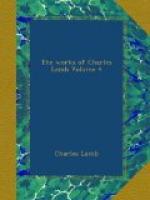“Time would run back and fetch the
age of gold,
And speckled Vanity
Would sicken soon and die,
And leprous Sin would melt from earthly
mould;
Yea, Hell itself would pass away,
And leave its dolorous mansions to the
peering day.”
[Footnote 1: It will be said these things are done in pictures. But pictures and scenes are very different things. Painting is a world of itself; but in scene-painting there is the attempt to deceive; and there is the discordancy never to be got over, between painted scenes and real people.]
The garden of Eden, with our first parents in it, is not more impossible to be shown on a stage, than the Enchanted isle, with its no less interesting and innocent first settlers.
The subject of Scenery is closely connected with that of the Dresses, which are so anxiously attended to on our stage. I remember the last time I saw Macbeth played, the discrepancy I felt at the changes of garment which he varied, the shiftings and reshiftings, like a Romish priest at mass. The luxury of stage-improvements, and the importunity of the public eye, require this. The coronation robe of the Scottish monarch was fairly a counterpart to that which our King wears when he goes to the Parliament house, just so full and cumbersome, and set out with ermine and pearls. And if things must be represented, I see not what to find fault with in this. But in reading, what robe are we conscious of? Some dim images of royalty—a crown and sceptre may float before our eyes, but who shall describe the fashion of it? Do we see in our mind’s eye what Webb or any other robe-maker could pattern? This is the inevitable consequence of imitating everything, to make all things natural. Whereas the reading of a tragedy is a fine abstraction. It presents to the fancy just so much of external appearances as to make us feel that we are among flesh and blood, while by far the greater and better part of our imagination is employed upon the thoughts and internal machinery of the character. But in acting, scenery, dress, the most contemptible things, call upon us to judge of their naturalness.




